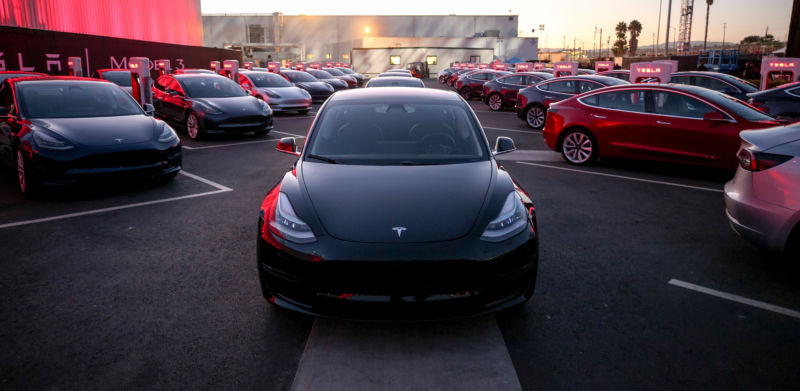
Tesla released its much-anticipated production numbers for the first quarter of 2018 this morning, and the results are mixed. The company produced 34,494 vehicles, an overall record for the electric vehicle company. But production numbers broken out by model leave something to be desired.
24,728 of the cars manufactured were Model S and Model X vehicles, down 3,592 from the 28,320 luxury vehicles that Tesla pushed out in Q4 2017.
That leaves us with Model 3 numbers: Tesla said it produced 9,766 Model 3 vehicles, up from an abysmal 2,425 it produced in Q4 2017. Tesla counts vehicles as “delivered” when all the paperwork has been done, so production and delivery numbers differ slightly. This quarter, Tesla delivered 8,180 vehicles, versus 1,550 delivered last quarter.
Tesla has a lot riding on those Model 3 production numbers. Investors have grown concerned as the company has struggled with what it has called “production hell.” In the past two weeks, the company’s shares sunk, not least because of a credit rating downgrade and poorly timed tweets from the company’s CEO. Reports of lackluster production numbers, a recent fatal crash involving a Tesla in Autopilot mode, and rumors that the National Transportation Safety Board is “unhappy” with the company didn’t help.
This morning’s news, however, seems to have assuaged investors. The company’s stock is ticking up 3 percent as of this writing.
Tesla is no stranger to rocky production ramp-ups—the Model X had its own troubles—but the Model 3 was supposed to be the company’s real moneymaker: a basic, lower-price, mass-produced car that would put electric vehicles in reach of upper-middle-class families.
The number that may be the most watched, however, are weekly Model 3 production numbers. In its last earnings call, Tesla said it would produce 2,500 Model 3s per week by the end of Q1. The company reported that in the last 7 days, it produced 2,020 vehicles. That’s 480 beneath what it promised, but possibly better than expected given rumors that circulated in advance of the Q1 deadline.
One thing complicating those numbers were rumors that Tesla shut down production of Model S and Model X on Thursday and Friday of last week, although Tesla says that the lines were only shut down on Friday. Ultimately, investors may either think that means the company is still struggling to meet its production quotas, or they may not care how the cars are made during the quarter, as long as they’re made.
Tesla’s press release is not wanting for optimism though. “The Model 3 output increased exponentially, representing a fourfold increase over last quarter,” the company wrote. “This is the fastest growth of any automotive company in the modern era. If this rate of growth continues, it will exceed even that of Ford and the Model T.”
That statement seems trite, though. Most companies are bound by the limits of real estate, labor, and capital and will not have exponential growth forever. Diminishing returns affect the best of us, and then new solutions will have to be found when growth rates decline.
For now, Tesla attributes its growth to “rapidly addressing production and supply chain bottlenecks, including several short factory shutdowns to upgrade equipment.”
The good news for investors is that Tesla is holding an earlier goal of 5,000 Model 3 vehicles per week by the middle of the year. This, Tesla says, sets the company up “to have the long-sought ideal combination of high volume, good gross margin and strong positive operating cash flow. As a result, Tesla does not require an equity or debt raise this year, apart from standard credit lines.”
https://arstechnica.com/?p=1287327

